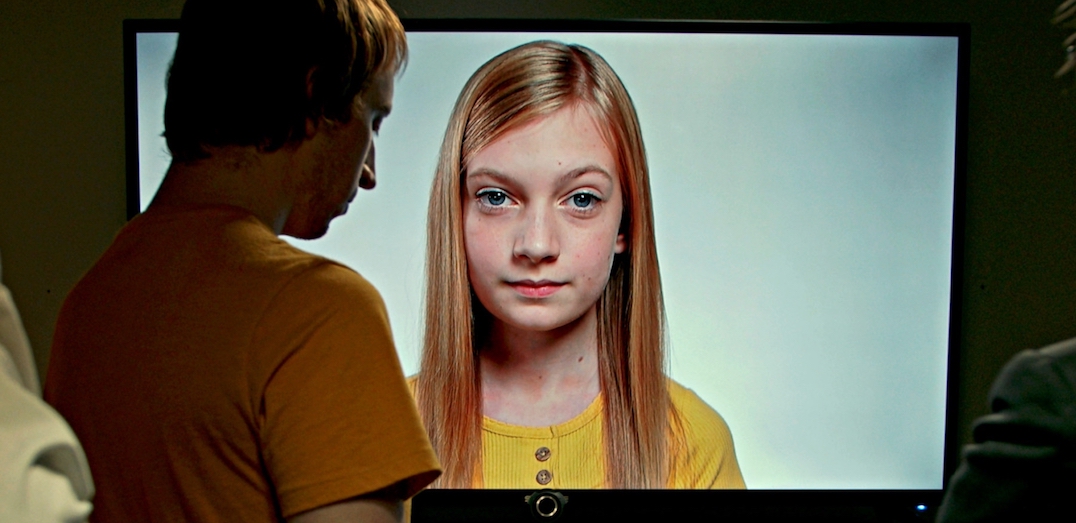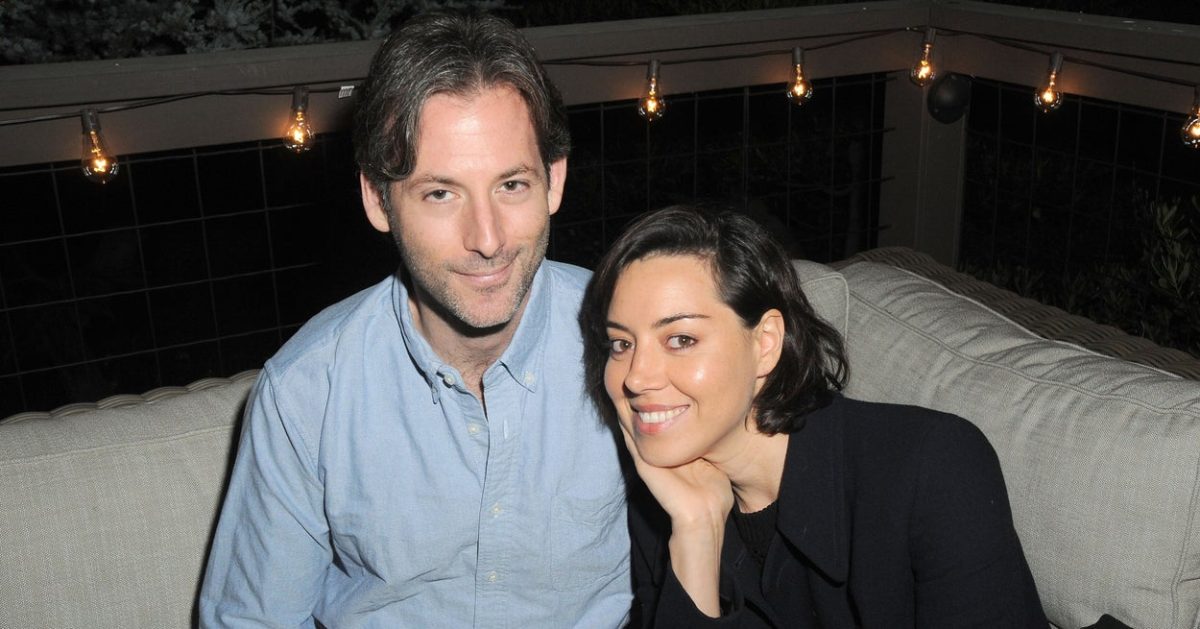
How The Artifice Girl Director Franklin Ritch Built a Dizzying New World With a Handful of Actors and Locations
May 14, 2023
Franklin Ritch wrote, directed and stars in The Artifice Girl, playing a programmer named Gareth whose new creation sparks vital questions about self-awareness and consent. In the piece below, he explains how a character he initially called “Tech-Kid” evolved into Gareth, how his slowly unspooling secrets unlocked doors in the story, and how he didn’t use his micro budget and limited locations as an excuse for stagnant shots. —MM
When I started writing The Artifice Girl during the surreal spring of 2020, I had to make a very conscious decision as to its scope. A narrative about the long and tedious development of an advanced predator-hunting A.I. initially seemed ripe for a large-scale, globe-trotting, deposition-intercutting, three-hour epic — something akin to The Social Network or Catch Me if You Can.
Above all else, I wanted The Artifice Girl, a work of fiction, to feel like it could be just as real as those films based on true stories. It needed to evoke the same kind of grounded believability that Aaron Sorkin and Scott Alexander mastered in their adaptations of modern history. But unless I’m drafting a Dark City prequel as a writing exercise or adapting the Myst video game franchise (because I’m a weirdo), I have to consider if the script that I’m writing is actually… you know… possible to produce.
Along with audience appeal, marketability, and cultural relevance, a screenwriter also needs to consider budgetary efficiency. It’s unlikely anybody will produce your first feature film passion project for $20 million, no matter how good the script is.
How The Artifice Girl Does So Much More With Less
These realities could stifle creativity, restricting writers to small spaces, few characters, and a de-emphasis on visual storytelling. But coming from a background of zero-budget short films, my team and I love films that do more with much less. Ideally, you let your limitations focus your creativity into an untapped perspective. Paranormal Activity and Primer are excellent examples of limited resources fostering groundbreaking inspirations for effective and efficient storytelling.
Also Read: The Artifice Girl Poses Mind-Blowing Questions With Ruthless Efficiency
I wanted Artifice Girl to be bigger than anything my team and I had ever done before. The trick was writing a screenplay that would be engaging and sophisticated even with our production restrictions in mind. (Including not just the budget, but pandemic obstacles.) There are some spoilers ahead, so bail out if you like.
I started the process by charting out the first few necessary beats that follow the unnamed “tech-kid” protagonist:
— Tech-Kid is haunted by traumatic backstory
— Tech-Kid builds predator-hunting A.I.
— A.I. becomes smarter than Tech-Kid
— A.I. cleverly intersects Tech-Kid with an NGO
— NGO offers to help Tech-Kid (but he’s reluctant)
I realized this all needed to happen within the first 30 to 45 minutes of screentime. It was a lot, but luckily, it would all play out in two to three locations. I continued charting beats…
— Tech-Kid & NGO work together
— New partner suspects A.I. is hiding secret
— A.I. reveals said secret…
…Then, uh…
What was this all gonna build towards, anyways? I hadn’t yet figured out anybody’s deeper needs or, at the very least, a satisfying payoff. I shrugged, closed my laptop for a few days, and told myself the story was probably too ambitious.
About a week later, I was trying to think of unique ways to tell stories during lockdown. My friends and I had talked about virtual-staged-readings where we’d livestream a few actors reading scripts and stageplays for both entertainment and workshopping purposes. I wondered if The Artifice Girl was suited for that kind of medium. Maybe there was a world where the story could exist as both a film and a stage play?
I re-approached the draft with that in mind: A stripped-down 30-minute scene where NGO agents confront and interrogate the Tech-Kid, revealing his A.I. counterpart and debating their potential collaboration. Best of all, it could be entirely Covid-safe, should the project ever be brought to a real set: Three characters sitting around a table while a fourth character is displayed on a monitor. All in one location. Hey, that’s kinda neat. But it also might be boring. The dialogue would have to do the heavy lifting. How does one turn technical short-hand and dumps of exposition into compelling cinema?
The trailer for The Artifice Girl, directed by Franklin RitchHow Criminal Interrogration Videos Inform The Artifice Girl
I looked at real criminal interrogation videos. They were especially intriguing when I didn’t know anything about the crime. It forced me, as an audience member, to use real context clues to try and figure out what this suspect was being accused of. I felt like a detective-fly on the wall. It was exhilarating.
These professional interrogators had a rhythm — a pace at which they would disseminate bits of information to suspects, forcing them to expose seemingly trivial insights, before enclosing them in a tense power dynamic where the suspects could only assume that the interrogators already knew everything.
I tried to implement that pacing into The Artifice Girl, making sure every page was either setting up another enticing mystery or revealing a preexisting secret. This back and forth of mystery and information helped keep the exposition from feeling obligatory. The audience, like the agents, would thirst for more.
Starting the narrative at the interrogation rather than the beginning of Tech-Kid’s origin story was so much more interesting. Out of the gate, there were questions: Who is this guy? What does he know? How much do the agents know? Best of all, this approach provided that coveted feeling of realism. That “fly on the wall” effect helped ground the fantastical science-fiction into a world more like the one we’re used to. Everything could be relatively familiar and believable so that the crazier futurisms in the later scenes would feel like a natural progression.
Through the process of structuring the first interrogation scene, I made the most important discovery: the story’s ultimate trajectory. I wrote a scene where the agents exit the room, leaving the main two characters to have a private conversation. There’s a single line of dialogue within that exchange that alludes to discourse over a yet-to-be revealed element of backstory.
After writing that line, I suddenly knew what the next 50 years of this fictional world would look like. The ending resolution was unmistakable, yet not entirely obvious. It just needed that one spark of discovery that often comes in the middle of drafting.
A still from The Artifice GirlForty-eight hours later, I had 91 pages written. The discovered parallel between repressed childhood trauma and the irrepressible adolescence of artificial intelligence is what fueled an active passion for the story. The limitations we knew we’d have while writing the screenplay directly inspired the unique structure and form of the film’s story.
Before securing the necessary funding for production, my team and I filmed a proof of concept section of the script. Because of Covid and timing, we had to plan our shots and setups with extreme precision. We knew the audience would get bored if we kept cutting back to the same stale shots over the course of the 35 minute conversation. We made sure to keep the angles dynamic as well as visually connected to the tone and theme of what was being said.
For such a seemingly simple scene, our setups were often quite elaborate. Social distancing heavily influenced the blocking and staging. Some takes even required compositing to make actors feel closer in proximity to each other. All of this required extensive pre-production planning.
My hope is that The Artifice Girl feels larger than its four walls. It took a lot of time and ingenuity from so many people on our team to help build the fictional world outside of the locations we filmed. I’m sure it won’t be the last movie to try and tell a large story in a small Covid-conscious space.
My advice for anyone working on this kind of project is to revisit the script. Consider alternative ways to frame your story. Maybe you’ll have a revelation that not only simplifies production, but also benefits the story you’re trying to tell.
The Artifice Girl is now available on all VOD formats.
Main image: Franklin Ritch and Tatum Matthews in The Artifice Girl.
Publisher: Source link
Aubrey Plaza Issues Statement After Jeff Baena’s Death
The 40-year-old star and Jeff’s family issued a statement to People on Monday, where they called their loss an “unimaginable tragedy.”The Los Angeles County coroner’s office previously determined that Jeff died by suicide in his LA home. He was 47…
Jan 10, 2025
Jill Duggar’s Husband Clarifies Where He Stands With Jim Bob Duggar
Jessa Duggar (m. Ben Seewald)Jim Bob and Michelle's fifth child, Jessa Duggar, was born Nov. 4, 1992. Jessa met Ben through church and he began courting her in 2013—the old-fashioned approach to romance coming as a brand-new notion to a lot…
Jan 10, 2025
The Internet Has Officially Lost It Over Andrew Garfield's Slutty Glasses
That man knew exactly what he was doing with those glasses.View Entire Post › Disclaimer: This story is auto-aggregated by a computer program and has not been created or edited by filmibee.Publisher: Source link
Jan 9, 2025
Armie Hammer Lands First Movie Role Since Cannibalism Allegations
Armie Hammer Cameos As “Kannibal Ken” in Music Video 4 Years After Cannibalism ClaimsArmie Hammer is heading back to the big screen. More than one year after the Los Angeles Police Department ended their lengthy investigation into the Call Me…
Jan 9, 2025











